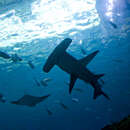en
names in breadcrumbs


Great hammerhead shark populations seem to be stable.
US Federal List: no special status
CITES: no special status
IUCN Red List of Threatened Species: endangered
These sharks are potentially dangerous to humans and cases of attacks by great hammerhead sharks have been documented.
Great hammerhead sharks are classified as game fish, as are all large hammerhead sharks. Their skin is often used for leather.
Great hammerhead sharks feed on rays, smaller sharks, and many species of bony fishes.
Great hammerhead sharks occur in all tropical waters worldwide.
Biogeographic Regions: oceanic islands (Native ); indian ocean (Native ); atlantic ocean (Native ); pacific ocean (Native )
These sharks are found in both open ocean and shallow coastal waters. During summer they may make small migrations towards more northerly areas.
Aquatic Biomes: reef ; coastal
Great hammerhead sharks posses a virtually straight anterior margin of the head with a deep central indentation. They have high second dorsal fins and the pelvic fins have curved rear margins. The teeth are triangular with extraordinarily serrated edges, becoming increasingly oblique toward the corners of the mouth. Their coloration varies from deep olive green to brownish grey above and white below. They are generally 4 to 6 m in length.
Range mass: 400 to 460 kg.
Other Physical Features: bilateral symmetry
Great Hammerhead sharks are viviparous. At a length of 3m, maturity is reached. Litters are made up of between 20 and 40 pups. Young are born in the summer season and are approximately 70 cm in length. Head shape of a newborn pup is more rounded than that of an adult but this changes as they grow.